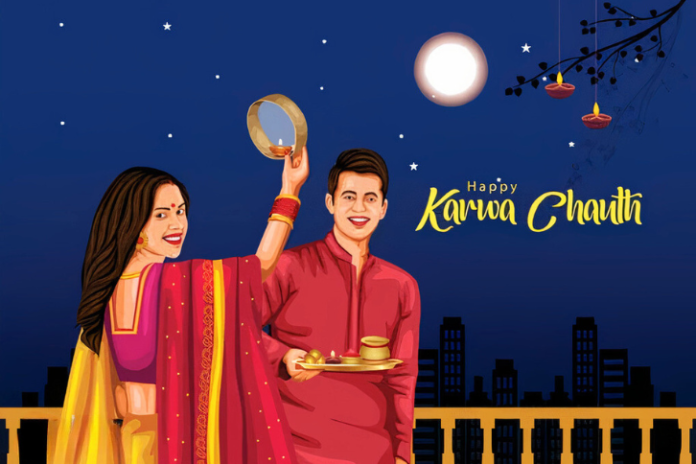The Religious Significance of Karwa Chauth (Karwa Chauth 2024)
Karwa Chauth is a revered Hindu festival celebrated primarily by married women in North India. This festival is marked by a day-long fast observed for the well-being and longevity of their husbands. The term “Karwa” refers to an earthen pot used during the rituals, and “Chauth” signifies the fourth day of the Krishna Paksha (waning phase of the moon) in the month of Kartik.
The religious significance of Karwa Chauth is deeply rooted in Hindu mythology and scriptures. One prominent legend links the festival to the Mahabharata, where Draupadi, the wife of the Pandavas, observed a similar fast for their safety and success during their exile. This act of devotion underscores the central theme of Karwa Chauth: the prayer and fasting by wives for the health and prosperity of their husbands.
The day begins before sunrise with a meal called “Sargi,” prepared by the mother-in-law and consumed by the fasting women. This meal typically includes fruits, sweets, and other nutritious items to sustain them throughout the day. The fast is strict, with women abstaining from food and water until they sight the moon in the evening.
Women spend the day dressing in their finest clothes, often traditional sarees or lehengas, and adorning themselves with jewelry and intricate henna designs on their hands. The afternoon is marked by a communal gathering where they listen to the Karwa Chauth story (Karwa Chauth Katha) and perform a prayer ceremony (Puja).
The Puja involves women sitting in a circle with their Karwas (earthen pots) filled with water, rice, and flowers. They pass the Karwas around while reciting prayers and singing traditional songs. An elder woman narrates the legend associated with Karwa Chauth, reinforcing the importance of the fast and the blessings it brings.
As night falls, women eagerly await the moonrise. They view the moon through a sieve or a dupatta (scarf) and offer water to it, praying for their husbands’ longevity and prosperity. The fast is broken by taking the first sip of water and a bite of food from their husbands’ hands, symbolizing mutual love and care.
Karwa Chauth is more than a ritualistic observance; it is a celebration of love, devotion, and the sacred marital bond. It highlights values of sacrifice, endurance, and deep emotional connection between husband and wife, reinforcing the strength and sanctity of marriage.
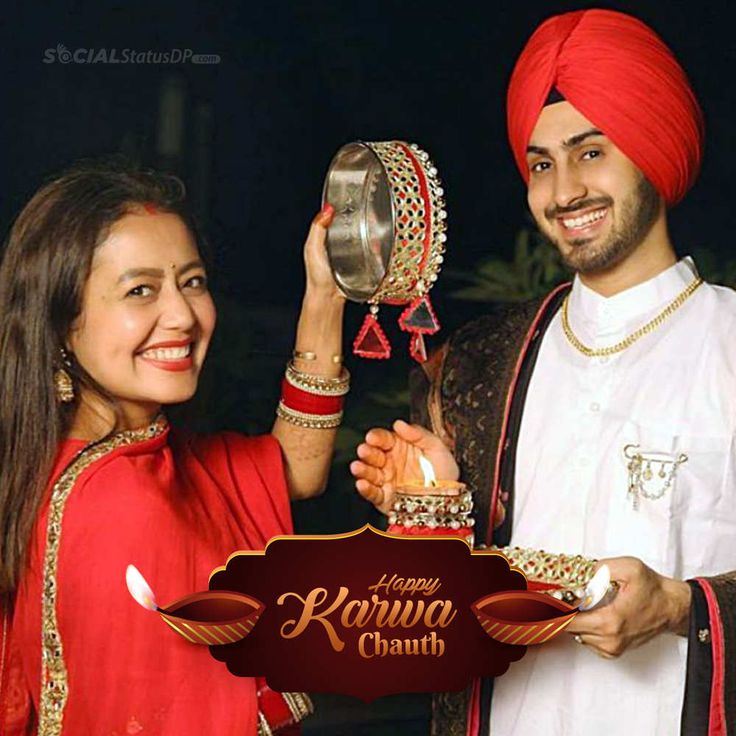
Karwa Chauth 2024 Date and Time
| Event | Details |
|---|---|
| Date | October 20, 2024 |
| Day | Sunday |
| Sargi Timing | Before sunrise |
| Fasting Start Time | Around 4:00 AM |
| Moonrise Time | Approximately 8:15 PM |
Karwa Chauth 2024 Mahurat
| Event | Details |
|---|---|
| Karwa Chauth Puja | Evening (exact time varies by location) |
| Chandrodaya | Time to break the fast (moonrise) |
| Karwa Chauth Katha | After evening Puja, before moonrise |
Additional Notes
- Sargi: Traditional pre-dawn meal prepared by the mother-in-law.
- Fasting: Women fast from sunrise until they see the moon.
- Puja Thali: Contains items for the evening prayers and rituals.
- Moonrise Time: Check local moonrise timings as it may vary slightly by location.
Mythological Stories Behind Karwa Chauth
Karwa Chauth is steeped in mythological stories that highlight its significance and the values it upholds. One of the most popular tales is that of Veeravati, a beautiful queen and the only sister of seven loving brothers.
Veeravati, after her marriage, observed her first Karwa Chauth. She began her fast with great devotion, but as the day progressed, she grew weak and anxious to see the moon. Her brothers, unable to see her suffer, created a mirror in a pipal tree that made it look like the moon had risen. Veeravati broke her fast, but soon after, she received the news of her husband’s death. Heartbroken, she prayed to Lord Shiva and Goddess Parvati, who revealed the deceit. They advised her to observe the fast with full devotion again, which she did, and her husband was revived.
Another legend is from the Mahabharata. Draupadi, the wife of the Pandavas, observed a fast similar to Karwa Chauth for their safety and well-being during their time of exile. Draupadi’s devotion and prayers helped the Pandavas overcome many challenges, emphasizing the power of a wife’s prayer and fasting for her husband’s protection and success.
Yet another story involves Karwa, a devoted wife whose husband was bitten by a snake. Using her strong will and devotion, she bound the snake with a cotton yarn and prayed to Yama, the god of death. Her devotion compelled Yama to restore her husband’s life. This tale underscores the power of a wife’s love and dedication in ensuring her husband’s well-being.
These mythological stories convey the essence of Karwa Chauth: unwavering devotion, the power of prayers, and the deep bond between husband and wife. They remind us of the values of sacrifice, faith, and the enduring strength of marital love.
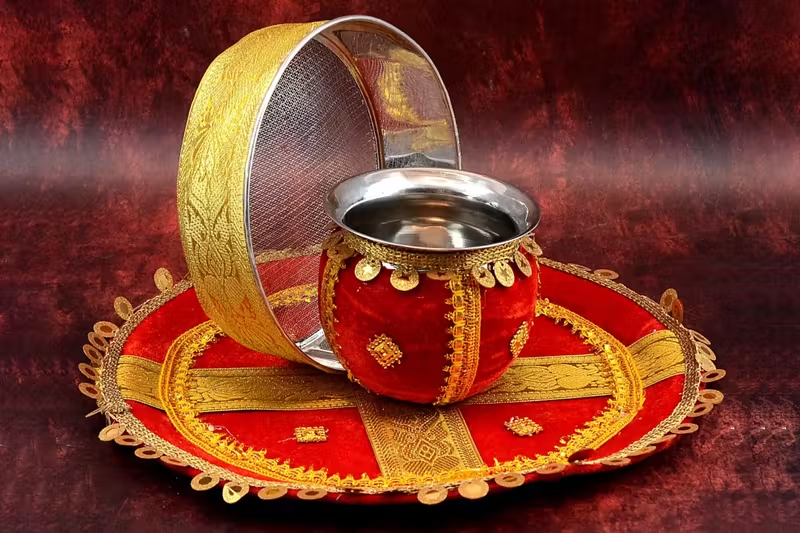
History and Origins of Karwa Chauth
The origins of Karwa Chauth can be traced back to ancient India, where it was primarily celebrated in the northern and northwestern regions. It is believed that the festival began as a community event to foster social bonds among women, particularly those who were newly married and had moved to their husband’s homes. This period of adjustment could be challenging, and Karwa Chauth provided a sense of community and support.
Historically, Karwa Chauth was also linked to the agricultural cycle. The festival coincided with the beginning of the Rabi crop season, and the earthen pots (Karwas) used during the rituals were filled with wheat grains and offered to the gods for a good harvest. This agricultural connection highlights the festival’s roots in the agrarian society of ancient India.
Over time, the festival evolved to focus more on marital devotion and the well-being of husbands. It became a day for women to pray for their husbands’ longevity and prosperity, reflecting the deep-rooted cultural and societal values placed on marriage and family.
The practice of fasting on Karwa Chauth is said to have been popularized by the Rajput queens, who observed this fast for their warrior husbands who often went to battle. The fast was a way to ensure their safe return and victory. This tradition gradually spread to other communities and became a widely observed festival across North India.
Karwa Chauth today is a blend of historical, cultural, and religious elements. It is celebrated with great enthusiasm and has become an integral part of the social fabric, symbolizing the strength and sanctity of marital bonds. The festival’s origins in community bonding, agricultural cycles, and marital devotion continue to be reflected in the way it is celebrated today.
The Rituals of Karwa Chauth Fasting
Karwa Chauth is renowned for its strict fasting rituals, which are observed with deep devotion by married women. The fast is kept from sunrise to moonrise, and women abstain from consuming food and water during this period. The day begins before dawn with a pre-dawn meal called “Sargi,” prepared by the mother-in-law. Sargi typically includes fruits, sweets, nuts, and other energy-giving foods to sustain the fasting women throughout the day.
After consuming Sargi, women dress in their finest clothes, often wearing traditional sarees or lehengas, and adorn themselves with jewelry and henna designs on their hands. They also perform morning prayers, seeking blessings for their husbands’ well-being.
Throughout the day, women engage in various rituals and preparations for the evening Puja (prayer) ceremony. They gather with other women in the community to listen to the Karwa Chauth story (Karwa Chauth Katha) and sing traditional songs. This communal gathering is an integral part of the festival, fostering a sense of camaraderie and shared devotion.
The Puja is a significant ritual of Karwa Chauth. Women sit in a circle with their Karwas (earthen pots) filled with water, rice, and flowers. They pass the Karwas around while reciting prayers and singing traditional songs. An elder woman narrates the legend associated with Karwa Chauth, reinforcing the importance of the fast and the blessings it brings.
As evening approaches, women eagerly await the moonrise. The sighting of the moon is essential for breaking the fast. Once the moon is visible, women view it through a sieve or a dupatta (scarf) and offer water to it, praying for their husbands’ longevity and prosperity. This ritual is known as “Chandra Darshan.”
After the moon sighting, women break their fast by taking the first sip of water and a bite of food from their husbands’ hands. This act symbolizes the mutual love and care between husband and wife, strengthening their marital bond.
The rituals of Karwa Chauth are a testament to the devotion and endurance of married women. They highlight the values of sacrifice, faith, and the deep emotional connection shared by husband and wife. By observing these rituals, women express their unwavering commitment to their husbands and seek divine blessings for a harmonious and prosperous married life.
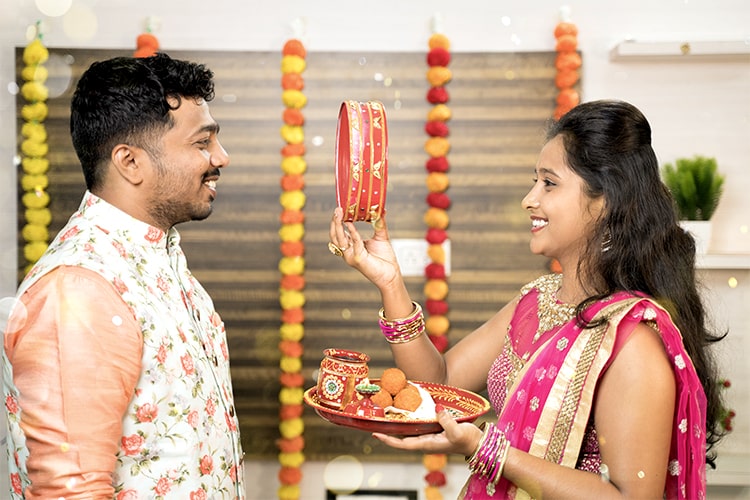
Special Puja Procedures on Karwa Chauth
The Puja (prayer) ceremony on Karwa Chauth is a significant aspect of the festival, embodying the devotion and spiritual fervor of married women. The Puja involves several rituals and procedures that are followed meticulously to seek blessings for the husbands’ well-being and longevity.
The Puja begins in the afternoon, as women gather with their Karwas (earthen pots) filled with water, rice, and flowers. These pots are symbolic and are used in the rituals. The women dress in their finest traditional attire, often wearing sarees or lehengas, and adorn themselves with jewelry and henna designs on their hands.
An elder woman, often the mother-in-law or an experienced member of the community, leads the Puja. She narrates the Karwa Chauth story (Karwa Chauth Katha), which is an essential part of the ceremony. The story typically revolves around the legends and myths associated with the festival, emphasizing the importance of the fast and the blessings it brings.
During the Puja, the women sit in a circle with their Karwas placed in front of them. They pass the Karwas around while reciting prayers and singing traditional songs. This act symbolizes the unity and shared devotion of the women. The prayers and songs are an expression of their wishes for their husbands’ health, prosperity, and long life.
One of the key elements of the Puja is the “Sargi,” a pre-dawn meal prepared by the mother-in-law. This meal includes a variety of food items such as fruits, sweets, nuts, and other nutritious foods. The women consume Sargi before sunrise, which helps sustain them throughout the day as they observe the fast.
In the evening, as the moonrise approaches, the anticipation among the women builds. The sighting of the moon is a crucial part of the Puja. Once the moon is visible, the women view it through a sieve or a dupatta (scarf) and offer water to it, praying for their husbands’ well-being. This ritual is known as “Chandra Darshan.”
After offering prayers to the moon, the women break their fast by taking the first sip of water and a bite of food from their husbands’ hands. This act of breaking the fast together symbolizes the mutual love and care between husband and wife, reinforcing their marital bond.
The special Puja procedures on Karwa Chauth are a reflection of the deep-rooted cultural and religious traditions associated with the festival. They highlight the values of devotion, sacrifice, and the sacred bond of marriage. Through these rituals, women express their unwavering commitment to their husbands and seek divine blessings for a harmonious and prosperous married life.
Benefits of Fasting on Karwa Chauth
Fasting on Karwa Chauth is more than a religious observance; it carries several benefits that go beyond the spiritual realm. While the primary motive is to pray for the well-being and longevity of husbands, the practice of fasting has numerous physical, mental, and emotional advantages.
- Physical Benefits: Fasting has long been known to offer various health benefits. It can help in detoxifying the body by giving the digestive system a break. This process allows the body to cleanse itself of toxins and waste products, promoting overall health. Additionally, fasting can help regulate blood sugar levels, improve metabolic function, and support weight management.
- Mental Benefits: The practice of fasting on Karwa Chauth requires discipline and self-control. It fosters a sense of mental strength and resilience as women abstain from food and water throughout the day. This act of willpower can enhance mental clarity and focus, helping individuals develop a greater sense of control over their desires and impulses.
- Emotional Benefits: Fasting on Karwa Chauth is an expression of love and devotion towards one’s husband. This act of sacrifice and prayer strengthens the emotional bond between husband and wife. It is a reminder of the deep connection and commitment that marriage entails. The shared experience of the fast and the rituals associated with it can bring couples closer, reinforcing their relationship.
- Spiritual Benefits: The religious significance of Karwa Chauth is paramount. Fasting is seen as a way to seek divine blessings for the husband’s well-being and longevity. The day is filled with prayers, rituals, and devotion, fostering a deep sense of spirituality. Engaging in these practices can bring inner peace, a sense of fulfillment, and a closer connection to the divine.
- Community and Social Benefits: Karwa Chauth is often celebrated as a community event, where women come together to observe the fast and perform the rituals. This sense of community fosters social bonds and provides support and encouragement. It is an opportunity for women to share their experiences, celebrate together, and strengthen their sense of belonging.
- Cultural and Traditional Benefits: Observing Karwa Chauth helps in preserving and passing down cultural and traditional values. It is a way to connect with one’s heritage and maintain the customs and practices that have been followed for generations. This cultural continuity is important for maintaining a sense of identity and belonging.
In conclusion, fasting on Karwa Chauth offers a holistic range of benefits that encompass physical health, mental resilience, emotional strength, spiritual fulfillment, social bonding, and cultural preservation. It is a multifaceted practice that enriches the lives of those who observe it, making it a deeply meaningful and cherished festival.
Decoration Ideas for Karwa Chauth
Karwa Chauth is a festival that is celebrated with much enthusiasm and joy. Decorating the home and surroundings adds to the festive spirit and creates a beautiful ambiance for the rituals and celebrations. Here are some decoration ideas to make Karwa Chauth special and memorable:
1. Traditional Rangoli: Rangoli designs made with colored powders, flowers, or rice are a beautiful way to decorate the entrance of the home. Choose traditional patterns or create unique designs that reflect the festive spirit of Karwa Chauth. Adding diyas (oil lamps) around the Rangoli can enhance its beauty.
2. Flower Decorations: Flowers are an integral part of any Indian festival. Use marigold, roses, and jasmine to create garlands and hang them around doorways, windows, and the Puja area. You can also create floral arrangements and place them in vases around the house.
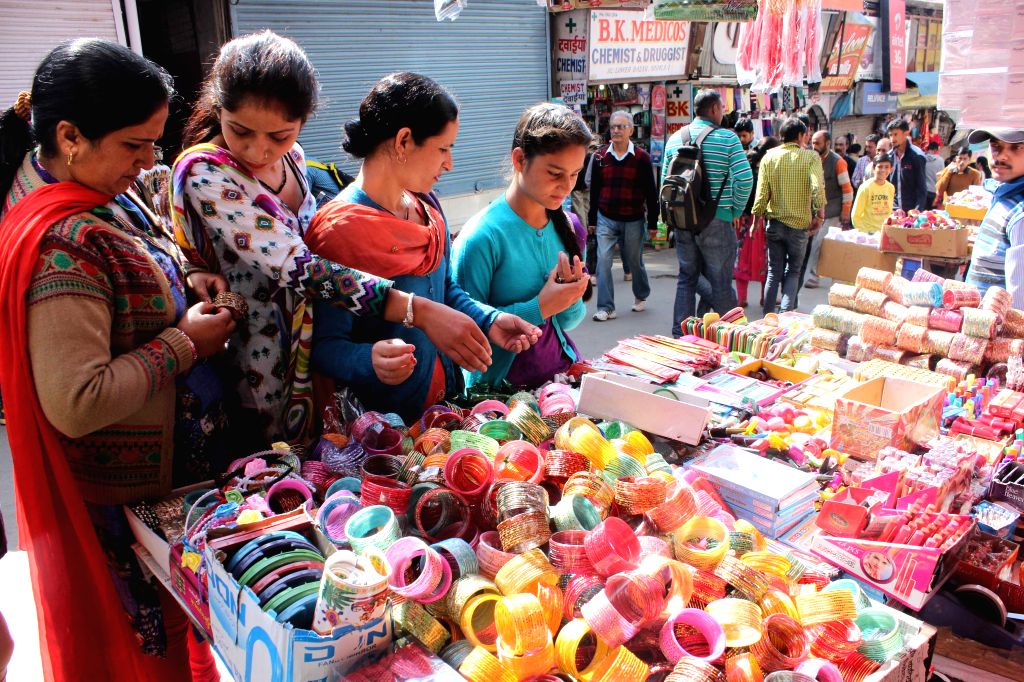
3. Decorated Puja Thali: The Puja thali (plate) used during the rituals can be beautifully decorated with traditional motifs, mirrors, beads, and lace. Arrange items like Karwa (earthen pot), diya, sindoor (vermillion), and sweets in an aesthetically pleasing manner.
4. Fairy Lights and Lanterns: String fairy lights or traditional lanterns around the house to create a warm and inviting atmosphere. Lights can be draped over windows, doorways, and even used to outline the Puja area. This adds a magical touch to the evening celebrations.
5. Themed Table Settings: If you plan to host a meal after the fast is broken, set the dining table with a festive theme. Use traditional tablecloths, vibrant napkins, and elegant dinnerware. Add small floral centerpieces and decorative candles to enhance the table setting.
6. Diyas and Candles: Lighting diyas (oil lamps) and candles is a significant part of Karwa Chauth. Place them around the house, especially near the Puja area and the Rangoli. You can use decorative diyas and scented candles to create a serene and festive ambiance.
7. Decorated Sieve (Chalni): The sieve used to view the moon during the ritual can also be decorated. Adorn it with lace, beads, and small mirrors to make it look special. This decorated sieve can be a lovely addition to the Puja.
8. Festive Drapes and Cushions: Change the regular drapes and cushions with vibrant, festive ones. Choose colors like red, gold, and orange that are associated with Indian festivals. This simple change can instantly uplift the décor of your living space.
9. Personalized Touches: Add personalized touches to your decorations. You can create a photo collage of your wedding or previous Karwa Chauth celebrations and display it. This adds a sentimental value to the décor.
10. Outdoor Decorations: If you have a garden or a balcony, decorate it with lights, flowers, and comfortable seating. This can be a perfect spot for moon sighting and breaking the fast.
These decoration ideas can help create a festive and joyful atmosphere for Karwa Chauth, making the celebration more special and memorable for you and your family.
Traditional Attire and Makeup for Karwa Chauth
Karwa Chauth is a special occasion where married women dress in their finest traditional attire and adorn themselves with beautiful makeup and jewelry. The festive look not only enhances their beauty but also reflects the cultural significance of the festival. Here are some traditional attire and makeup ideas for Karwa Chauth:
Traditional Attire:
1. Saree: A saree is a classic choice for Karwa Chauth. Opt for rich fabrics like silk, chiffon, or georgette in vibrant colors such as red, maroon, or orange. These colors are considered auspicious and symbolize love and marital bliss. Embellished sarees with zari, embroidery, or sequins can add a festive touch.
2. Lehenga Choli: Lehenga choli is another popular choice for Karwa Chauth. A heavily embroidered or embellished lehenga paired with a matching choli (blouse) and dupatta creates a regal look. Choose colors like gold, red, or pink to enhance the festive spirit.
3. Anarkali Suit: Anarkali suits are elegant and comfortable. These floor-length dresses with flared skirts and intricate embroidery are perfect for the occasion. Pair them with matching churidar or leggings and a dupatta to complete the look.
4. Salwar Kameez: For a more traditional yet comfortable option, you can opt for a salwar kameez. Choose a heavily embroidered kameez with a matching salwar and dupatta. Fabrics like silk, brocade, or velvet add a rich and festive feel.
Makeup:
1. Base Makeup: Start with a clean and moisturized face. Apply a primer to create a smooth base. Use a foundation that matches your skin tone and blend it well. Conceal any blemishes or dark circles with a concealer. Set the base with a translucent powder.
2. Eye Makeup: For the eyes, opt for warm and vibrant shades like gold, copper, or bronze. Apply a neutral shade on the eyelids and a darker shade on the crease for depth. Add a touch of shimmer to the center of the eyelids. Use a black or brown eyeliner to define your eyes and finish with mascara to enhance your lashes.
3. Cheeks: Use a blush in shades of pink or coral to add a healthy glow to your cheeks. Apply it on the apples of your cheeks and blend it upwards towards the temples.
4. Lips: For the lips, choose bold and bright colors like red, maroon, or pink. Apply a lip liner to define the shape of your lips and fill them in with your chosen lipstick shade. Add a touch of gloss for a shiny finish.
5. Highlight and Contour: Highlight the high points of your face like the cheekbones, bridge of the nose, and brow bone with a highlighter. Use a contour powder to define your jawline and cheekbones for a sculpted look.
6. Bindi and Sindoor: Complete your traditional look with a bindi on your forehead. Apply sindoor (vermillion) along the parting of your hair as a mark of marital status.
Jewelry:
1. Earrings: Chandbalis, jhumkas, or traditional earrings adorned with pearls and gemstones add a touch of elegance to your attire.
2. Necklaces: Opt for a statement necklace like a choker or a long necklace with intricate designs. You can also layer multiple necklaces for a regal look.
3. Bangles: Wear matching bangles or kadas (thick bracelets) to adorn your wrists. Glass or metal bangles in vibrant colors enhance the traditional look.
4. Maang Tikka and Nath: A maang tikka worn on the forehead and a nath (nose ring) add to the traditional charm. Choose pieces that complement your outfit and makeup.
By dressing in traditional attire and applying elegant makeup, you can enhance the beauty and significance of Karwa Chauth, making it a memorable and joyous celebration.
The Tradition of Moon Sighting on Karwa Chauth
The tradition of moon sighting, or “Chandra Darshan,” is one of the most anticipated and significant rituals of Karwa Chauth. It marks the culmination of the day’s fast and holds deep religious and cultural significance.
On the evening of Karwa Chauth, after a day of strict fasting, women eagerly await the moonrise. The moon’s appearance is essential for breaking the fast, and the anticipation builds as the evening progresses. Families and friends often gather on rooftops or open spaces to catch the first glimpse of the moon.
The moon sighting ritual is a beautiful and symbolic act. Once the moon is visible, women perform the “Chandra Puja” by offering water, sweets, and prayers to the moon. This ritual is known as “Arghya.” They hold a sieve or a dupatta (scarf) and look at the moon through it, followed by looking at their husbands through the same sieve. This act symbolizes the filtering of any negativity and seeking blessings for their husbands’ long life and prosperity.
The sieve or dupatta holds symbolic meaning. It represents the separation of any evil or obstacles from the lives of the couple, ensuring a harmonious and prosperous marital life. The moon is considered a representation of peace, tranquility, and the divine presence, and seeking its blessings is believed to bring positivity and well-being.
After offering prayers to the moon, the fast is broken. The husband feeds the first sip of water and a bite of food to his wife, symbolizing his care and love. This gesture reinforces the bond between husband and wife and signifies the mutual respect and affection they share.
The tradition of moon sighting on Karwa Chauth is more than a ritualistic practice. It is a moment of deep emotional connection and spiritual fulfillment. The act of fasting and praying together strengthens the marital bond and reaffirms the commitment and devotion of the couple.
In many communities, the moon sighting is celebrated with communal gatherings, where women come together to share their experiences and offer support to each other. This sense of community adds to the joy and significance of the festival.
In conclusion, the tradition of moon sighting on Karwa Chauth is a cherished and meaningful ritual that encapsulates the essence of the festival. It is a celebration of love, devotion, and the enduring bond of marriage, making it a deeply fulfilling and joyous occasion.
Karwa Chauth Stories and Folk Songs
Karwa Chauth is rich in cultural heritage, with stories and folk songs playing a significant role in the festivities. These stories and songs are passed down through generations, adding depth and meaning to the celebration.
Karwa Chauth Stories:
1. The Legend of Veeravati: One of the most popular Karwa Chauth stories is that of Veeravati, a beautiful queen and the only sister of seven loving brothers. Veeravati, after her marriage, observed her first Karwa Chauth with great devotion. As the day progressed, she grew weak and anxious to see the moon. Her brothers, unable to see her suffer, created a mirror in a pipal tree to make it look like the moon had risen. Veeravati broke her fast, but soon after, she received the news of her husband’s death. Heartbroken, she prayed to Lord Shiva and Goddess Parvati, who revealed the deceit and advised her to observe the fast with full devotion again. Veeravati’s devotion brought her husband back to life.
2. The Story of Karwa: Another significant story is that of Karwa, a devoted wife whose husband was bitten by a snake. Using her strong will and devotion, she bound the snake with a cotton yarn and prayed to Yama, the god of death. Her devotion compelled Yama to restore her husband’s life. This tale underscores the power of a wife’s love and dedication in ensuring her husband’s well-being.
3. The Mahabharata Connection: The Mahabharata also has a story linked to Karwa Chauth. Draupadi, the wife of the Pandavas, observed a fast similar to Karwa Chauth for their safety and well-being during their exile. Draupadi’s devotion and prayers helped the Pandavas overcome many challenges, emphasizing the power of a wife’s prayer and fasting for her husband’s protection and success.
Folk Songs:
Karwa Chauth is also celebrated with traditional folk songs that add to the festive spirit. These songs are sung during the Puja and throughout the day, creating a joyful and vibrant atmosphere.
1. Sargi Songs: These songs are sung early in the morning while consuming Sargi, the pre-dawn meal. They express the blessings and love from the mother-in-law and set a positive tone for the day.
2. Puja Songs: During the Puja, women gather and sing traditional songs that narrate the stories of Karwa Chauth and express their devotion. These songs are often passed down through generations and are an integral part of the rituals.
3. Celebration Songs: In the evening, after breaking the fast, celebration songs are sung to mark the joyous occasion. These songs reflect the happiness and gratitude of the women for the successful completion of the fast and the blessings received.
Examples of Folk Songs:
1. “Karwa Chauth Ka Vrat Aaya”: This song celebrates the arrival of Karwa Chauth and the excitement of observing the fast. It is a popular song that sets the festive mood.
2. “Saas Meri Pyari”: This song expresses the love and gratitude of a daughter-in-law towards her mother-in-law for preparing the Sargi. It highlights the bond between the women in the family.
3. “Chand Dekhne Ka Waqt Aaya”: Sung in the evening, this song builds the anticipation of moon sighting and reflects the excitement of breaking the fast.
In conclusion, the stories and folk songs of Karwa Chauth add cultural richness and emotional depth to the festival. They celebrate the devotion, love, and enduring bond between husband and wife, making Karwa Chauth a cherished and meaningful celebration.
Some frequently asked questions (FAQs) about Karwa Chauth
1.What is Karwa Chauth?
Karwa Chauth is a traditional Hindu festival where married women fast from sunrise to moonrise for the well-being and longevity of their husbands.
2.When is Karwa Chauth celebrated?
Karwa Chauth is celebrated on the fourth day after the full moon in the Hindu month of Kartik, which usually falls in October or November.
3.Why do women fast on Karwa Chauth?
Women fast on Karwa Chauth to pray for their husbands’ long lives, prosperity, and safety. It is believed that the fast strengthens the bond between husband and wife.
4.What do women do during the fast?
Women begin the day with a pre-dawn meal called “Sargi,” prepared by their mothers-in-law. They then observe a day-long fast, refraining from food and water. In the evening, they dress up in traditional clothes, apply henna, and perform rituals with a Karwa (clay pot) filled with water.
5.How do women break the fast?
Women break the fast after sighting the moon. They look at the moon through a sieve, offer prayers, and then see their husbands’ faces through the sieve. The husbands then give their wives the first sip of water and a bite of food to break the fast.
6.What are some traditional customs of Karwa Chauth?
- Applying mehndi (henna) on hands and feet
- Wearing new or special clothes, often in red or bright colors
- Exchanging gifts between family members
- Gathering with other women to perform Karwa Chauth rituals together
- Listening to or reading the Karwa Chauth story (Katha)
7.Can unmarried women observe Karwa Chauth?
Yes, some unmarried women observe Karwa Chauth in hopes of finding a good husband or for the well-being of their fiancés.
8.Is the fast compulsory?
No, observing the fast is a personal choice. Some women may choose not to fast due to health reasons or personal beliefs.
9.What is the significance of the Karwa (clay pot)?
The Karwa symbolizes prosperity and is used during the rituals. Women fill the Karwa with water and offer it to the moon as part of the prayer.
10.Are there any health tips for women observing the fast?
- Eat a nutritious Sargi with a balance of carbs, proteins, and fats
- Stay hydrated before the fast starts
- Avoid strenuous activities during the day
- Break the fast with something light and nutritious
Karwa Chauth is a festival rooted in love, faith, and tradition, celebrated with great enthusiasm by many Hindu women.

